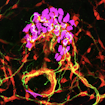On December 9 and 10, the Simons Foundation Autism Research Initiative (SFARI) hosted a Circuit Dynamics Workshop to explore the role of neural circuits in autism. Researchers gathered to discuss how coordinated activity among many neurons might manifest into autism-related behaviors.
All the investigators who attended are Simons Foundation grantees who focus on neural dynamics in awake, behaving rodent models of autism. Many were recently selected through a request for applications (RFA) for autism research on neural circuits, released in April 2014. In offering an RFA specifically for research on systems-level neural dynamics, SFARI aimed to fill a gap in understanding between cellular and synaptic dysfunction in autism, and overt, autism-related behaviors. In addition, some grantees work on the same rodent models of autism. It is hoped that this strategy will yield common circuit signatures within single mouse models, and perhaps across multiple models as well. The Circuit Dynamics Workshop offered these grantees an opportunity to discuss their experiences with the models and to share ideas with colleagues.
While the attending investigators work at the forefront of neural circuit research, many are new to autism research, and the meeting provided context to these researchers. Presentations from SFARI staff introduced investigators to what is known about the genetics and neurobiology of autism in humans and to how this may be back-translated for study of neural circuits in animal models.
“The meeting was excellent,” says Loren M. Frank of the University of California, San Francisco. “The foundation encouraged a wide-ranging discussion of the issues we all face in attempting to identify circuit-level alterations in models of autism.”
Because some investigators are in the early stages of their projects, cross-pollination of ideas was particularly useful. Some widely applicable topics discussed at the meeting were the hurdles to managing large amounts of data, and how investigators’ work may be related to the Simons Collaboration on the Global Brain (SCGB), which aims to achieve a mechanistic understanding of the healthy brain.
“It was clear that the same quantitative, large-scale approaches currently being developed to study normal circuit function are also the right approaches to uncover how circuit function is perturbed in animal models of autism,” says Daniel Feldman of the University of California, Berkeley.
On the second day of the workshop, speakers explored how tools being developed by the Simons Center for Data Analysis (SCDA) may be implemented to better understand the large and complex systems of neurons that produce behavior in individuals with autism. By working closely with SCDA, autism researchers may be able to more efficiently decipher patterns between circuit function and behavior.
It is hoped that these neural circuit researchers, together with investigators from SCGB and SCDA, will break new ground on how circuit function affects autism.


